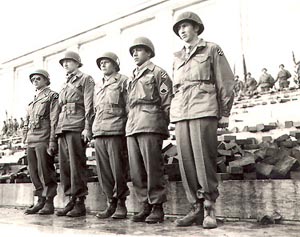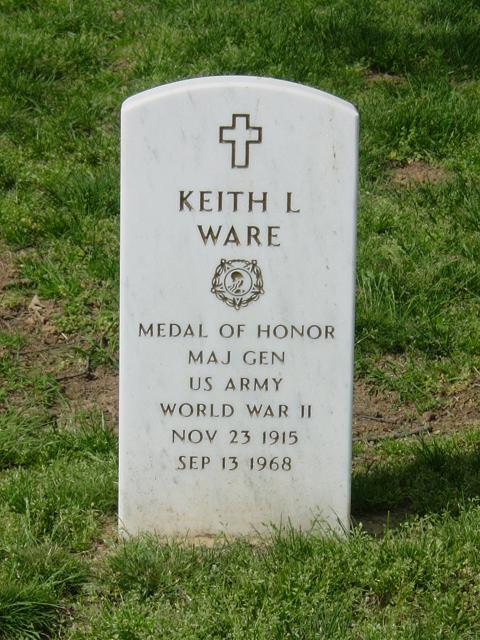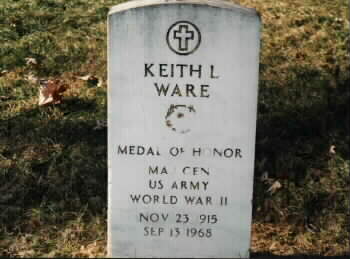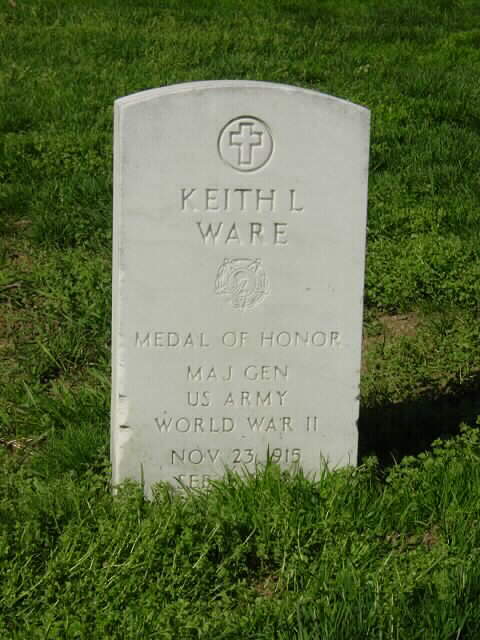Born on November 23, 1915, Keith Lincoln Ware was awarded the Medal of Honor for service in World War II. He was a career Army officer.
General Ware was the Commanding General of the 1st Infantry Division and was killed on September 13, 1968 as his command helicopter crashed in flames near the Cambodian border during the Vietnam War.
An Army spokesman said that eight persons were believed to have been aboard the craft when it went down in the jungle about 60 miles north of Saigon. There were no survivors. He and three staff officers were reported aboard the helicopter with the normal crew of four. It was not immediately determined whether the craft had been shot down by enemy fire. The spokesman said that there was no ground action in the immediate area at the time. He further stated that the bodied had ben recovered. The craft crashed in dense jungle growth about seven miles south of the Cambodian border and three miles southeast of Loc-nihn.
The 52-year-old General, who had joined the Army a a draftee in World War II, was the fourth American General killed in the Vietnam War. He had been in Vietnam about nine months at the time of his death.
He is buried in Section 30 of Arlington National Cemetery.
Courtesy of the Audie Murphy Website
Ask 10 people on Fort Hood who Keith L. Ware was and 90 percent, if not all, cannot answer the question unless they are in public affairs. Ask the same 10 percent who Audie Murphy was and chances are they can all answer.
Ware and Murphy served together in World War II and had great respect for each other. They were also friends who few could equal in combat. While one would become a celebrity, the other would go on to a distinguished military career and be immortalized by the Army for three decades of dedication to his country.
They way they fought and died were similar and, today they rest in peace a short distance apart in Arlington National Cemetery.
Murphy's legend lives on in books, movies and by word-of-mouth. He even has a worldwide fan club, a foundation and an Internet homepage. The Army continues to recognize him through the Sergeant Audie Murphy Club, where only non-commissioned officers that display his leadership qualities are eligible for induction.
Ware's name is synonymous with Army journalistic excellence. The annual Keith L. Ware competition recognizes outstanding Army journalists in honor of the former Army Chief of Public Affairs. His name also graces the distinguished visitor quarters at Fort Hood, Keith Ware Hall.
Ware, the first Officers' Candidate School graduate to reach the rank of general and the highest-ranking officer killed during the Vietnam War, was an unassuming hero who went where the action was.
That is how he got to know Murphy up close and personal on October 2, 1944.
Murphy saved Ware's life that day by single-handedly rescuing a 15th Infantry Regiment patrol near the Cleuire Rock Quarry in France – thereby earning his first Silver Star, according to copyrighted information recently received from Terry Murphy, son of the most decorated combat soldier of World War II.
Lieutenant Colonel Ware, 1st Battalion executive officer, had joined a small patrol probing German lines where he and the others were helplessly pinned down by an enemy machine gun with rifle support.
Staff Sergeant Murphy, who was not part of the patrol, had recognized the danger and secretly followed behind about 25 yards. “I figured those gentlemen were going to run into trouble; so I tagged along … to watch the stampede” he told newspaper columnist and friend David McClure years later.
As the German machine gunner was about to finish off Ware and the patrol, Murphy stepped into the open just eight yards from the enemy. Murphy's famous luck was with him as the enemy gun barrel caught some brush as it swung around.
Murphy finished off all eight ambushers with two grenades and his carbine in less than 30 seconds. That earned Murphy his first Silver Star, but a modest Murphy failed to even mention the incident in his autobiography “To Hell and Back.”
Just three days later, Murphy would be credited with inflicting 50 enemy casualties in a single engagement and earn a second Silver Star.
A day before that action, according to author Harold B. Simpson in “Audie Murphy – American Soldier,” Murphy took Ware along on one of his dangerous sniper hunts. Ware was witness to Murphy outdueling a sniper and capturing a prized high-powered rifle and scope that Life Magazine photographed and published.
Ware never forgot the sharpshooting boyish Texan who saved his life. In 1964, as a brigadier general, he said “Audie Murphy was without a doubt the finest soldier I have ever known in my entire military career.”
And Ware knew what courage was. When one of his assault companies was stopped and forced to dig in on December 26, 1944, Ware personally went to get them moving.
Ware exposed himself to heavy German artillery, machine gun and mortar fire for two hours scouting a fortified hill 150 yards beyond friendly lines.
He then went back to the American line, armed himself with an automatic rifle and led a small group in attacking the stronghold. He took out four German machine gun positions and an undetermined number of enemy casualties.
Murphy went on to become the most decorated American combat soldier of World War II, have a long movie career and a somewhat noted songwriter.
Ware went on to receive the Medal of Honor for his December 26 exploit in World War II and then to fight one of the greatest battles of the Vietnam War.
Ware was known for keeping his cool under fire and instilling confidence in those around him. Vietnam was no exception.
It has been almost 30 years since the Viet Cong attempted to overwhelm the United States and its allies with an all-out assault stretching from the southern capital city of Saigon to the northern provincial capital of Hue City.
Although Major General Ware's name never became synonymous with the Tet Offensive of 1968, it was he who organized and led the successful defense of Saigon – North Vietnam's brass ring.
The attacks began on January 31, corps commander Lieutenant General Frederick C. Weyland had been analyzing recent enemy troop movements and he anticipated the surprise, according to Keith W. Nolan in “The Battle for Saigon.”
Weyland ordered Ware to Saigon on February 1, after the coordinated Viet Cong attack reached even into the U.S. Embassy there.
Forming Task Force Ware, the general assumed operational control of all American fighting units fighting in and around the South Vietnamese capital.
Just like the patrol at Cleuire Rock Quarry and during the Battle of the Bulge, Ware wanted to be up front and see the situation first hand.
Under heavy fire several times himself, Ware calmly went about his business of clearing the enemy from the city. After 18 days of fighting, Ware dismantled his task force and let the South Vietnamese Army claim the honor of winning the battle.
After Tet, Ware took command of the 1st Infantry Division, the Big Red One, and again he refused to command from the rear.
On September 13, 1968, there was a lot of activity near An Loc and Ware decided to fly up there and get a handle on what was going on, David D. Hack, a former companion of Ware's said in a telephone interview recently from Akron, Ohio.
Hack was a Ranger sergeant in the 1st Infantry Division. After Hack was wounded in April 1968, Ware appointed him as his NCOIC of Protocol.
“Basically, I protected his back – plain and simple”, Hack said. Hack went everywhere with Ware, except on that Friday the 13th when a young lieutenant ordered Hack off the aircraft so he could take his seat.
The lieutenant told Hack the general wanted him to travel to An Lock with a armored unit. When Hack protested and told the officer he did not believe him, the lieutenant harshly ordered him off the aircraft.
Also on board the Huey helicopter was Command Sergeant Major Joseph Veneable, for whom Fort Hood's Veneable Village is named.
The final passenger was King, the general's great white German Shepherd given to him by Long Range Recon Patrol members. King went everywhere with Ware. He died with him, too.
Hack said he believes the helicopter was hit by a Rocket Propelled Grenade because the Huey exploded in mid-air. On his way to meet a commander that would never show, Hack earned a second Purple Heart when his vehicle was struck by an RPG.
Hack had many late night conversations with Ware, who he said was very pleasant and a true professional, but he never talked about himself – or Murphy.
Murphy never forgot Ware and considered him a good friend. He took the news report of Ware's death very hard. Murphy died just three years later in an airplane crash on May 28, 1971 in Virginia.
In 1971, Command Sergeant Major Gary G. Beylickjian, who had met Ware in Vietnam, was the only enlisted soldier in the Office of the Chief of Public Affairs. That October, it was decided the Army's annual journalism awards need some character, Beylickjian recalled last week at his Maryland business.
Adding the name Keith L. Ware was the solution and in 1972, Beylickjian was part of the ceremony honoring the first Keith L. Ware Award winners. Mrs. Ware was on hand to help with the presentation.
As for the question of who was Keith L. Ware, maybe the answer is simply an American soldier. Some people might say hero, but Ware never did.
On April 22, 1945, Lt. Gen. A. M. Patch, Seventh Army Commander,
conferred the Medal of Honor on five 3rd Division officers and men.
Left to right: Lt. Col. Keith L. Ware, Lt. John J. Tominac, T/Sgt. Russell E. Dunham, S/Sgt. Lucien Adams, and Pfc. Wilburn K. Ross.
(Photo Courtesy of the National Archives)
WARE, KEITH L.
Rank and organization: Lieutenant Colonel, U.S . Army, 1st Battalion, 1 5th Infantry, 3d Infantry Division. Place and date: Near Sigolsheim, France, 26 December 1944. Entered service at: Glendale, California. Born: 23 November 1915, Denver, Colorado. G.O. No.: 47, 18 June 1945.
Citation:
Commanding the 1st Battalion attacking a strongly held enemy position on a hill near Sigolsheim, France, on 26 December 1944, found that 1 of his assault companies had been stopped and forced to dig in by a concentration of enemy artillery, mortar, and machinegun fire. The company had suffered casualties in attempting to take the hill. Realizing that his men must be inspired to new courage, Lt. Col. Ware went forward 150 yards beyond the most forward elements of his command, and for 2 hours reconnoitered the enemy positions, deliberately drawing fire upon himself which caused the enemy to disclose his dispositions. Returning to his company, he armed himself with an automatic rifle and boldly advanced upon the enemy, followed by 2 officers, 9 enlisted men, and a tank. Approaching an enemy machinegun, Lt. Col. Ware shot 2 German riflemen and fired tracers into the emplacement, indicating its position to his tank, which promptly knocked the gun out of action. Lt. Col. Ware turned his attention to a second machinegun, killing 2 of its supporting riflemen and forcing the others to surrender. The tank destroyed the gun. Having expended the ammunition for the automatic rifle, Lt. Col. Ware took up an Ml rifle, killed a German rifleman, and fired upon a third machinegun 50 yards away. His tank silenced the gun. Upon his approach to a fourth machinegun, its supporting riflemen surrendered and his tank disposed of the gun. During this action Lt. Col. Ware's small assault group was fully engaged in attacking enemy positions that were not receiving his direct and personal attention. Five of his party of 11 were casualties and Lt. Col. Ware was wounded but refused medical attention until this important hill position was cleared of the enemy and securely occupied by his command.
WARE, KEITH L
MG USA
- VETERAN SERVICE DATES: Unknown
- DATE OF BIRTH: 11/23/1915
- DATE OF DEATH: 09/13/1968
- DATE OF INTERMENT: 09/17/1968
- BURIED AT: SECTION 30 SITE 258-3
- ARLINGTON NATIONAL CEMETERY
Michael Robert Patterson was born in Arlington and is the son of a former officer of the US Army. So it was no wonder that sooner or later his interests drew him to American history and especially to American military history. Many of his articles can be found on renowned portals like the New York Times, Washingtonpost or Wikipedia.
Reviewed by: Michael Howard




